Collection, Standardization and Attribution of Robust Disaster Event Information—A Demonstrator of a National Event-Based Loss and Damage Database in Austria
Abstract
:1. Introduction
2. Study Framework
3. Data
3.1. Data Description
3.2. Data Management and Protection
4. Data Model, Data Harmonization, Event Identification and Information Retrieval
4.1. Data Model
4.2. Harmonization Process
- The definition of the target schemes and formats of the variables to be harmonized, i.e., date, location, type of natural hazard, type of the affected element, extent of damage/loss, object owner, loss ownership, data source, event ID and composite ID. All definitions are based on international standards and recommendations (e.g., [11,20]) as well as national standards and practices.
- The analysis of the original data towards relevant information for the demonstrator. For each target variable, we compare the source with the target scheme and assess the harmonization need and potential. The defined target schemes are not completely rigid constructs. If the analysis of a new dataset suggests a reasonable extension or adaptation of a target scheme, corresponding modifications are possible and envisaged.
- The creation of the mapping, i.e., rules and processes to transform the source into the target scheme. These rules and processes may differ depending on the dataset and the target variable. They may involve converting the unit of measurement, using validation data, or collapsing to the lowest common denominator. The latter may also require the use of assumptions or involve a loss of detail.
- The transformation of the dataset by applying the rules and processes developed in step 3. Moreover, events are uniquely identified and, if necessary, merged to composites. In addition to a predefined list of major events, any events already imported into the demonstrator are considered within this process—and redefined if necessary.
- The insertion of the harmonized dataset into the demonstrator.
4.2.1. Definition of Target Schemes
4.2.2. Controlled Vocabulary
4.2.3. Event Identification/Description
- Datasets with events as key elements, where each documented event usually has its unique identifier. The “event” forms the spatial/temporal reference unit. Several phenomena, damages and/or losses may be assigned to this reference unit.
- Datasets with damages and losses as key elements, where single damage/loss entries or (emergency) operations usually get unique identifiers but are not assigned to concrete events.
4.3. Supporting Event Identification and Description
4.4. Technical Implementation and Framework
5. Results
6. Discussion
- The risk of overlapping or multiple event entries: The original datasets partly show differences in how they define and classify events as well as uncertainties and inaccuracies with respect to date and location of an event. These differences, uncertainties and inaccuracies complicate the identification of coinciding events across different sources and lead to the risk of overlapping or double counted events in the “harmonized” dataset. The validity of the “harmonized” dataset in terms of the number of events is therefore limited. By contrast, the risk of multiple loss counts in the “harmonized” dataset is low, since the harmonization procedure requires selecting the most reliable and/or comprehensive source in case of potentially overlapping loss data. What is still not implemented, but will be followed up, is the indication how different data sources contribute to harmonized loss and damage numbers.
- Imprecise differentiation in source data: Uncertainties in the original datasets due to imprecise differentiation with respect to the type of hazard or the type of affected element are automatically transferred to the “harmonized” dataset.
- Differing loss definitions: Especially the documentations of the Provincial Administrations, who collect loss data in the course of processing compensation payments, may differ in what they define as “eligible” loss—i.e., loss entitled to receive allowance—and hence, in the extent of loss documentation. Depending on the state, motor vehicles are for instance eligible for compensation or not. Full harmonization might be difficult, especially if the respective affected object is not reported as stand-alone category, but part of a broader category of affected elements. Wherever retrospective harmonization is not possible, definitional differences are reported in the metadata.
- Algorithm for event and composite ID: The algorithm for merging events across different sources and assigning IDs still shows potential for further optimization. In the current version, the grouping is based on the (start) date, geographical proximity and matching of types of natural hazards. Meteorological data, on the other hand, has not yet been integrated into the algorithm. Their inclusion has only been tested in a semi-automated process with a high share of manual work. Especially for larger events that extend over several days, the additional consideration of meteorological data provides noticeable improvements in the resulting event definitions but is quite time-consuming when not fully automated. The future goal is therefore to incorporate meteorological data into the automated algorithm and to refine it further.
Author Contributions
Funding
Data Availability Statement
Acknowledgments
Conflicts of Interest
References
- European Environment Agency. Economic Losses and Fatalities from Weather- and Climate-Related Events in Europe; European Environment Agency: Copenhagen, Denmark, 2022. [Google Scholar] [CrossRef]
- World Meteorological Organization (WMO). W.M. WMO Atlas of Mortality and Economic Losses from Weather, Climate and Water Extremes (1970–2019) (WMO-No. 1267); WMO: Geneva, Switzerland, 2021; ISBN 978-92-63-11267-5. [Google Scholar]
- Münchner Rückversicherungs-Gesellschaft. TOPICS Geo Natural Catastrophes 2017; Munich Re: Munich, Germany, 2017. [Google Scholar]
- Gall, M.; Borden, K.A.; Cutter, S.L. When Do Losses Count?: Six Fallacies of Natural Hazards Loss Data. Bull. Am. Meteorol. Soc. 2009, 90, 799–810. [Google Scholar] [CrossRef]
- Blaike, P.; Cannon, T.; Davis, I.; Wisner, B. At Risk: Natural Hazards, People’s Vulnerability and Disasters; Routledge: London, UK, 2004; ISBN 978-0-415-25216-4. [Google Scholar]
- Birkmann, J.; Cardona, O.; Carreño, M.; Barbat, A.; Pelling, M.; Schneiderbauer, S.; Kienberger, S.; Keiler, M.; Alexander, D.; Zeil, P.; et al. Framing Vulnerability, Risk and Societal Responses: The MOVE Framework. Nat. Hazards J. Int. Soc. Prev. Mitig. Nat. Hazards 2013, 67, 193–211. [Google Scholar] [CrossRef]
- IPCC. Climate Change 2022: Impacts, Adaptation, and Vulnerability; Contribution of Working Group II to the Sixth Assessment Report of the Intergovernmental Panel on Climate Change; Pörtner, H.-O., Roberts, D.C., Tignor, M., Poloczanska, E.S., Mintenbeck, K., Alegría, A., Craig, M., Langsdorf, S., Löschke, S., Möller, V., et al., Eds.; Cambridge University Press: Cambridge, MA, USA, 2022. [Google Scholar]
- World Economic Forum. The Global Risks Report 2022; World Economic Forum: Cologny, Switzerland, 2022; ISBN 978-2-940631-09-4. [Google Scholar]
- De Groeve, T.; Corbane, C.; Poljanšek, K.; Ehrlich, D. Current Status and Best Practices for Disaster Loss Data Recording in EU Member States; Publications Office of the European Union: Luxembourg, 2014; ISBN 978-92-79-43549-2. [Google Scholar]
- Poljanšek, K.; Valles, A.; Marin Ferrer, M.; De Jager, A.; Dottori, F.; Galbusera, L.; Garcia Puerta, B.; Giannopoulos, G.; Girgin, S.; Hernandez Ceballos, M.; et al. Recommendations for National Risk Assessment for Disaster Risk Management in EU (2019); Publications Office of the European Union: Luxembourg, 2019. [Google Scholar] [CrossRef]
- United Nations. Sendai Framework for Disaster Risk Reduction 2015–2030; United Nations Office for Disaster Risk Reduction (UNISDR): Geneva, Switzerland, 2015; p. 37. [Google Scholar]
- Centre for Research on the Epidemiology of Disasters (CRED) EM-DAT: The OFDA/CRED International Disaster Database. Available online: https://www.cred.be/ (accessed on 25 April 2022).
- Munich Re. NatCatSERVICE—Natural Catastrophe Know-How for Risk Management and Research; Munich Re: Munich, Germany, 2016. [Google Scholar]
- Köberl, J.; Prettenthaler, F.; Schubert, C. DAMAGE.at—Machbarkeitsanalyse Des Aufbaus Einer Österreichweiten Schadendatenbank Zu Wetter- und Klimabedingten Infrastrukturschäden Project Report. Graz, Austria, 2018. Available online: https://www.joanneum.at/en/life/publications/detail/damageat-machbarkeitsanalyse-des-aufbaus-einer-oesterreichweiten-schadendatenbank-zu-wetter-und-klimabedingten-infrastrukturschaeden (accessed on 21 February 2022).
- De Groeve, T.; Ehrlich, D.; Poljanšek, K. Recording Disaster Losses: Recommendations for a European Approach; Publications Office of the European Union: Luxembourg, 2013; ISBN 978-92-79-32690-5. [Google Scholar]
- Rudolf-Miklau, F. Naturgefahren-Management in Österreich, 1st ed.; LexisNexis ARD ORAC: Vienna, Austria, 2009; ISBN 978-3-7007-4109-1. [Google Scholar]
- Tilch, N.; Kociu, A.; Haberler, A.; Melzner, S.; Schwarz, L.; Lotter, M. The Data Management System Georios of the Geological Survey of Austria (GBA); Geological Survey of Austria—Department of Engineering Geology: Vienna, Austria, 2011; p. 1. [Google Scholar]
- Bundesministerium für Nachhaltigkeit und Tourismus. Richtlinie für den Wilbach- und Lawinenkataster (WLK-RL); Bundesministerium für Nachhaltigkeit und Tourismus: Vianna, Austria, 2018. [Google Scholar]
- Kaufmann, A.; Schnetzer, I.; Spira, Y. Leitfaden zur Erfassung und Dokumentation von Hochwasserereignissen in der Hochwasser-Fachdatenbank; Bundesministerium für Land- und Forstwirtschaft, Umwelt und Wasserwirtschaft: Vienna, Austria, 2013. [Google Scholar]
- De Groeve, T.; Corbane, C.; Ehrlich, D. Guidance for Recording and Sharing Disaster Damage and Loss Data: Towards the Development of Operational Indicators to Translate the Sendai Framework into Action Actionreduction Translate the Sendai Framework into Action; EUR 27192; JRC95505; Publications Office of the European Union: Luxembourg, 2015. [Google Scholar]
- Integrated Research on Disaster Risk. Guidelines on Measuring Losses from Disasters: Human and Economic Impact Indicators; Integrated Research on Disaster Risk: Beijing, China, 2015. [Google Scholar]
- ASU. Center for Emergency Management and Homeland Security the Spatial Hazard Events and Losses Database for the United States, Version 20.0 2022. Available online: https://cemhs.asu.edu/sheldus (accessed on 25 April 2022).
- Sudmanns, M.; Augustin, H.; van der Meer, L.; Baraldi, A.; Tiede, D. The Austrian Semantic EO Data Cube Infrastructure. Remote Sens. 2021, 13, 4807. [Google Scholar] [CrossRef]
- Guzzetti, F.; Peruccacci, S.; Rossi, M.; Stark, C.P. The Rainfall Intensity-Duration Control of Shallow Landslides and Debris Flows: An Update. Landslides 2008, 5, 3–17. [Google Scholar] [CrossRef]
- Enigl, K.; Matulla, C.; Schlögl, M.; Schmid, F. Derivation of Canonical Total-Sequences Triggering Landslides and Floodings in Complex Terrain. Adv. Water Resour. 2019, 129, 178–188. [Google Scholar] [CrossRef]
- Antofie, T.-E.; Luoni, S.; Marin Ferrer, M.; Faiella, A. Risk Data Hub—Web Platform to Facilitate Management of Disaster Risks; JRC Technical Report; JRC: Ispra, Italy, 2019; ISBN 978-92-76-01385-3. [Google Scholar] [CrossRef]
- UNISDR. From Shared Risk to Shared Value–The Business Case for Disaster Risk Reduction; Global Assessment Report on Disaster Risk Reduction; United Nations Office for Disaster Risk Reduction (UNISDR): Geneva, Switzerland, 2013. [Google Scholar]
- Llasat, M.C.; Llasat-Botija, M.; Petrucci, O.; Pasqua, A.A.; Rossello, J.; Vinet, F.; Boissier, L. Towards a database on societal impact of Mediterranean floods within the framework of the HYMEX project. Nat. Hazards Earth Syst. Sci. 2013, 13, 1337–1350. [Google Scholar] [CrossRef] [Green Version]
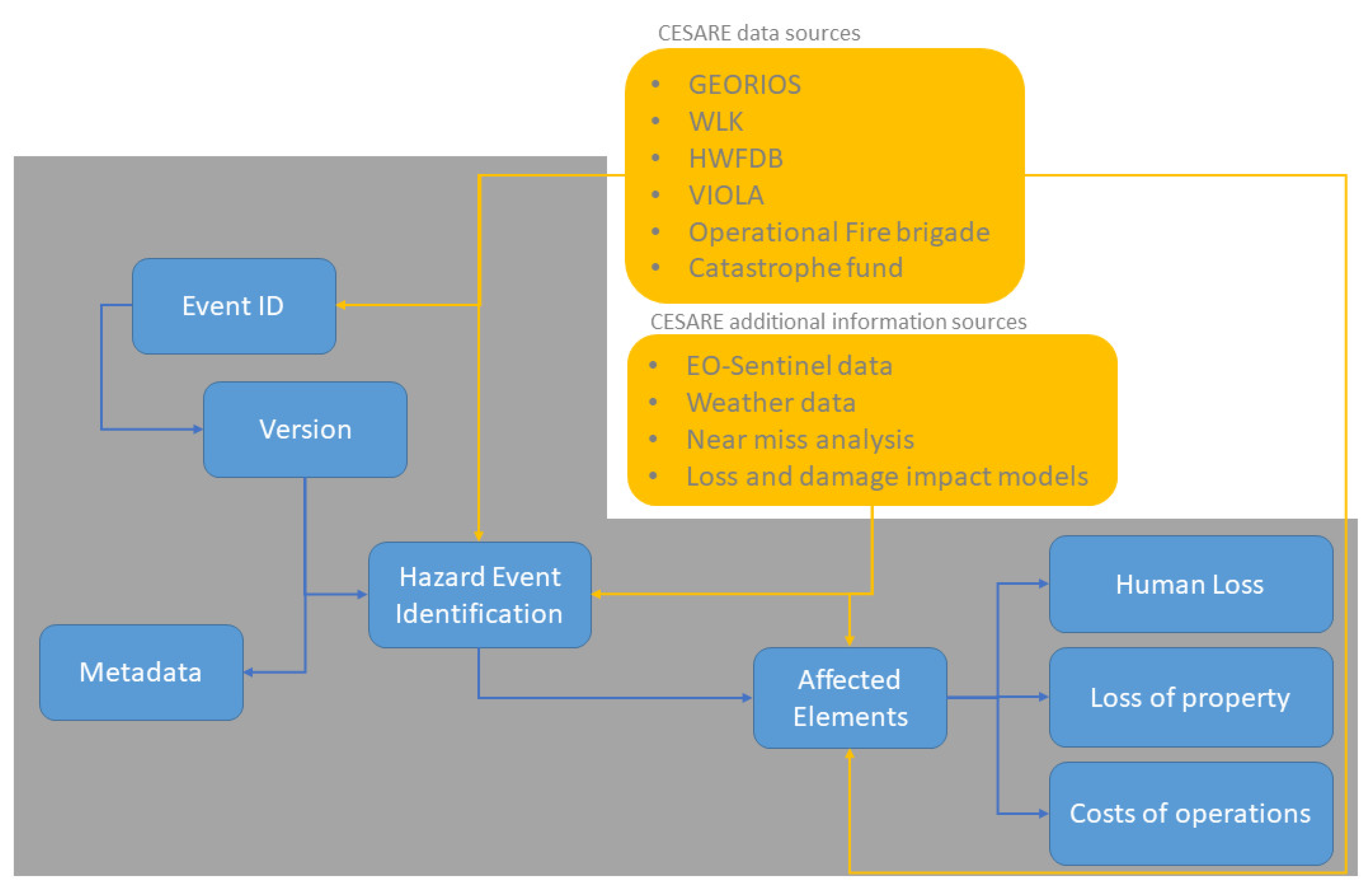

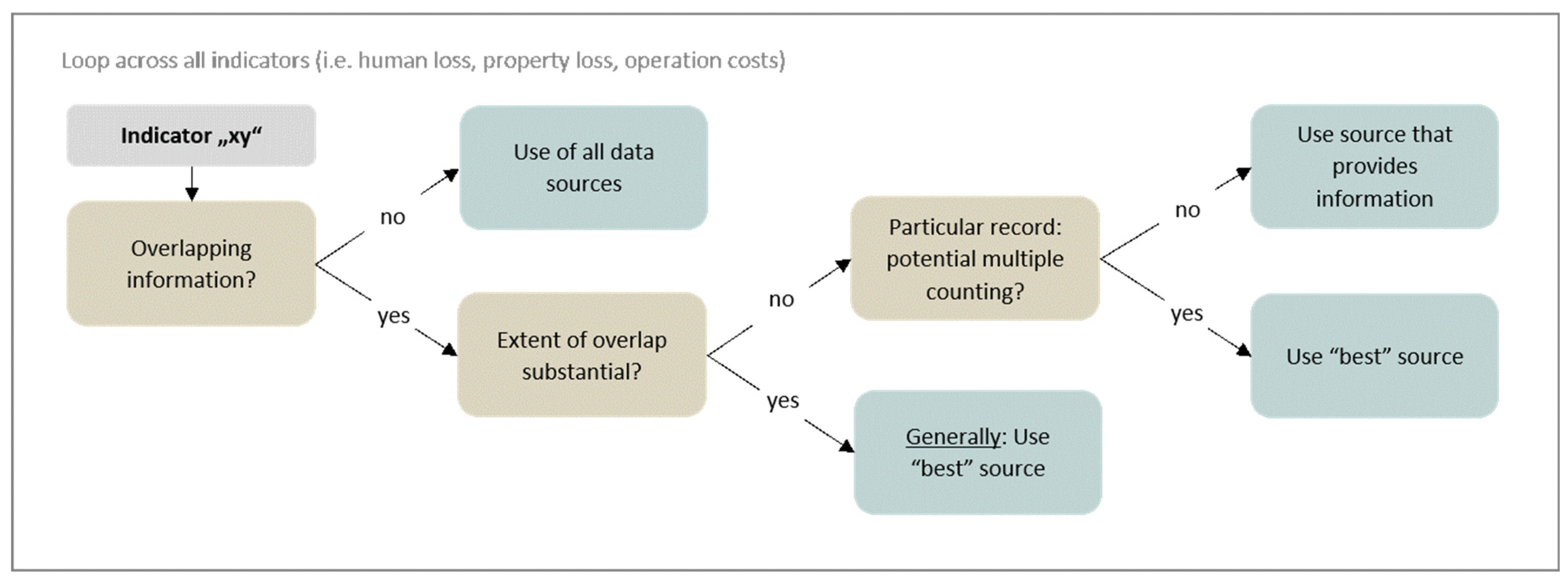
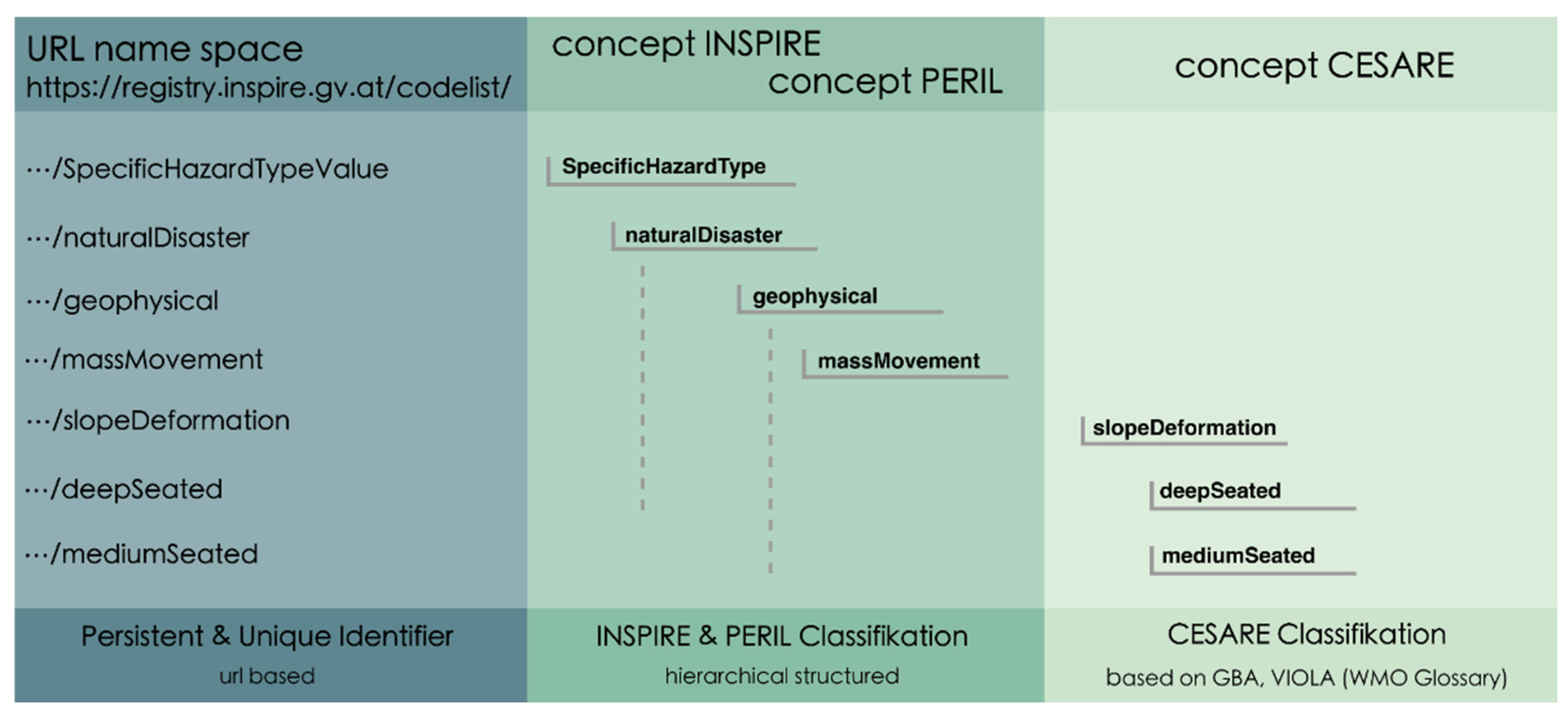
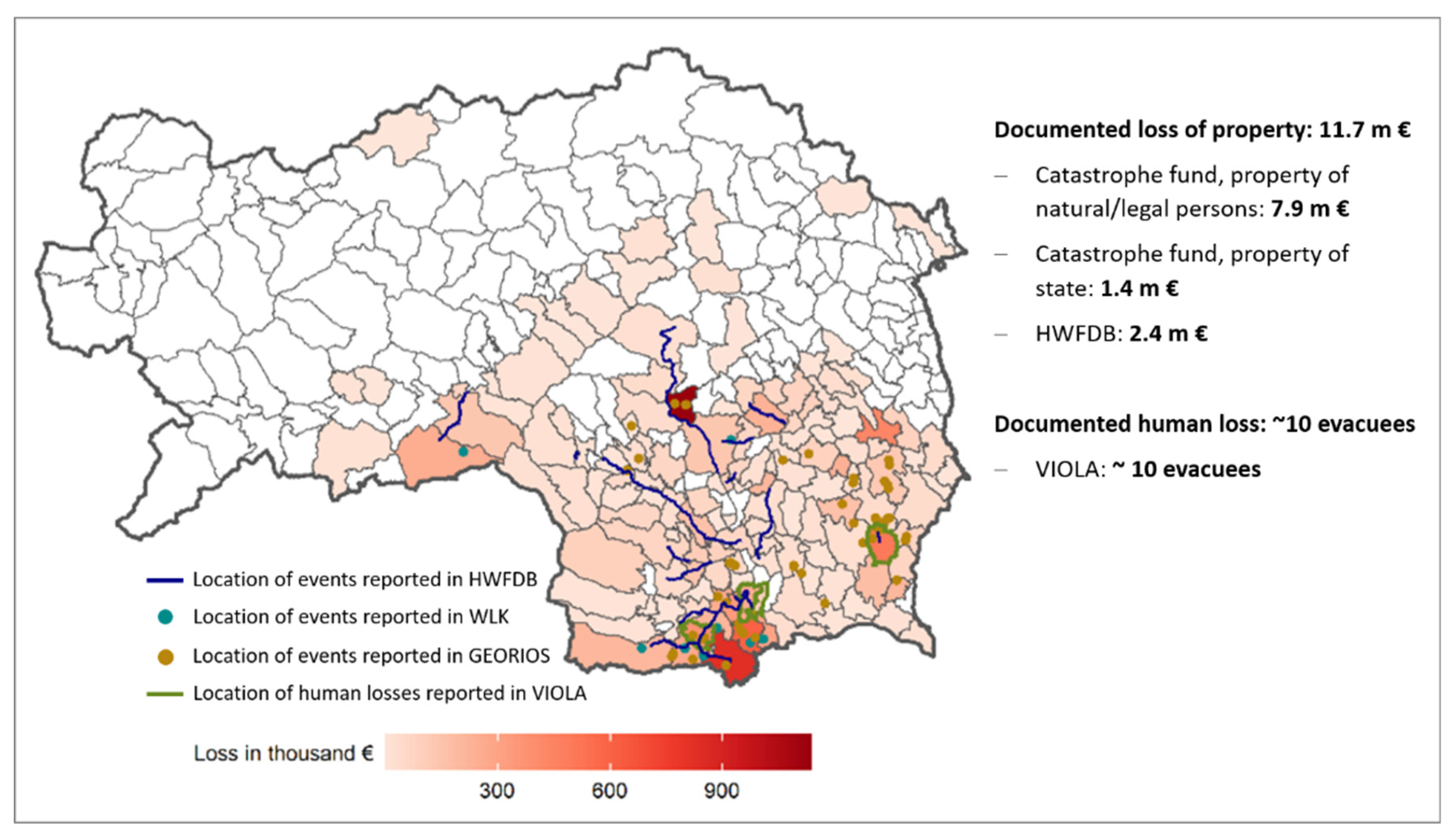
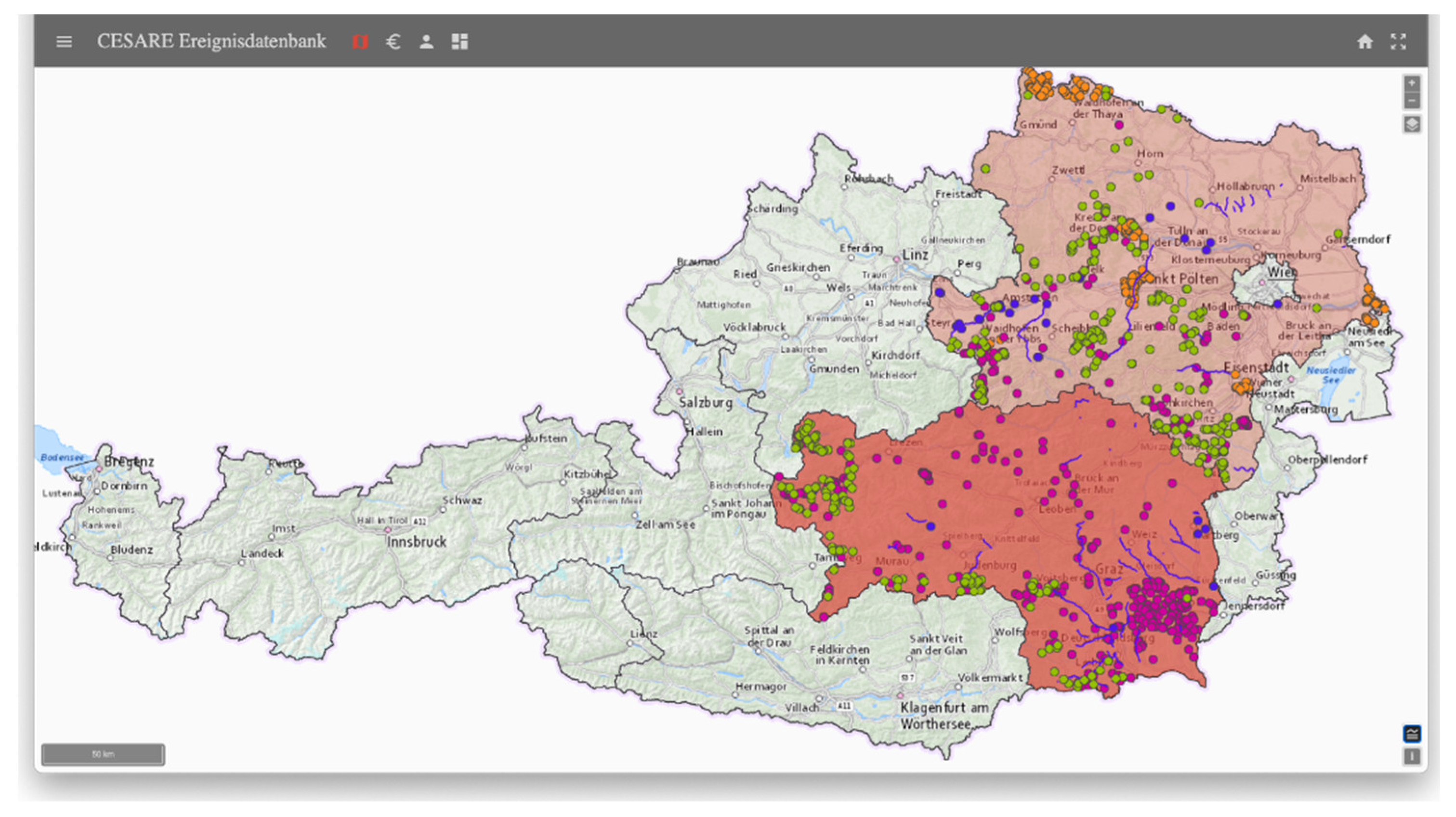
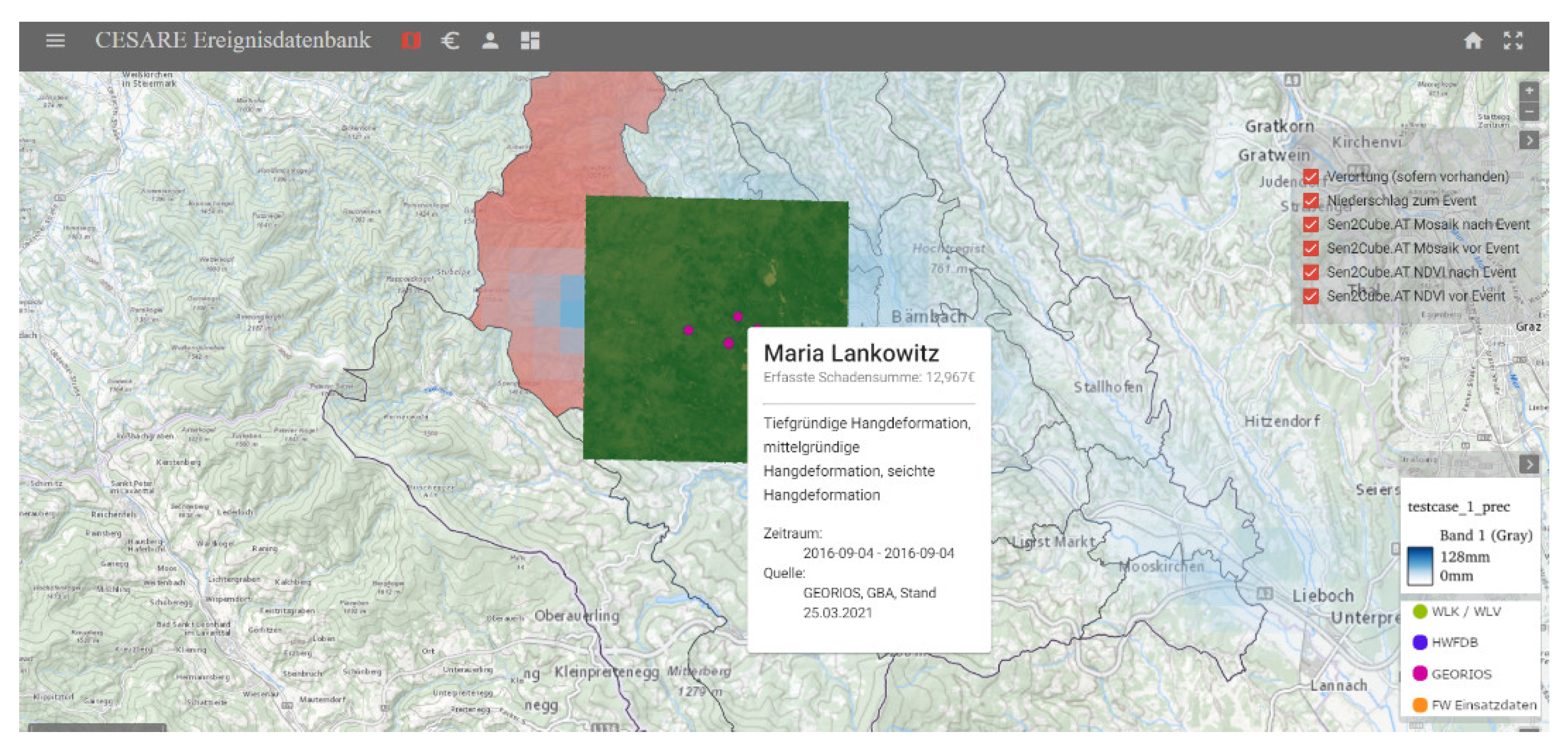
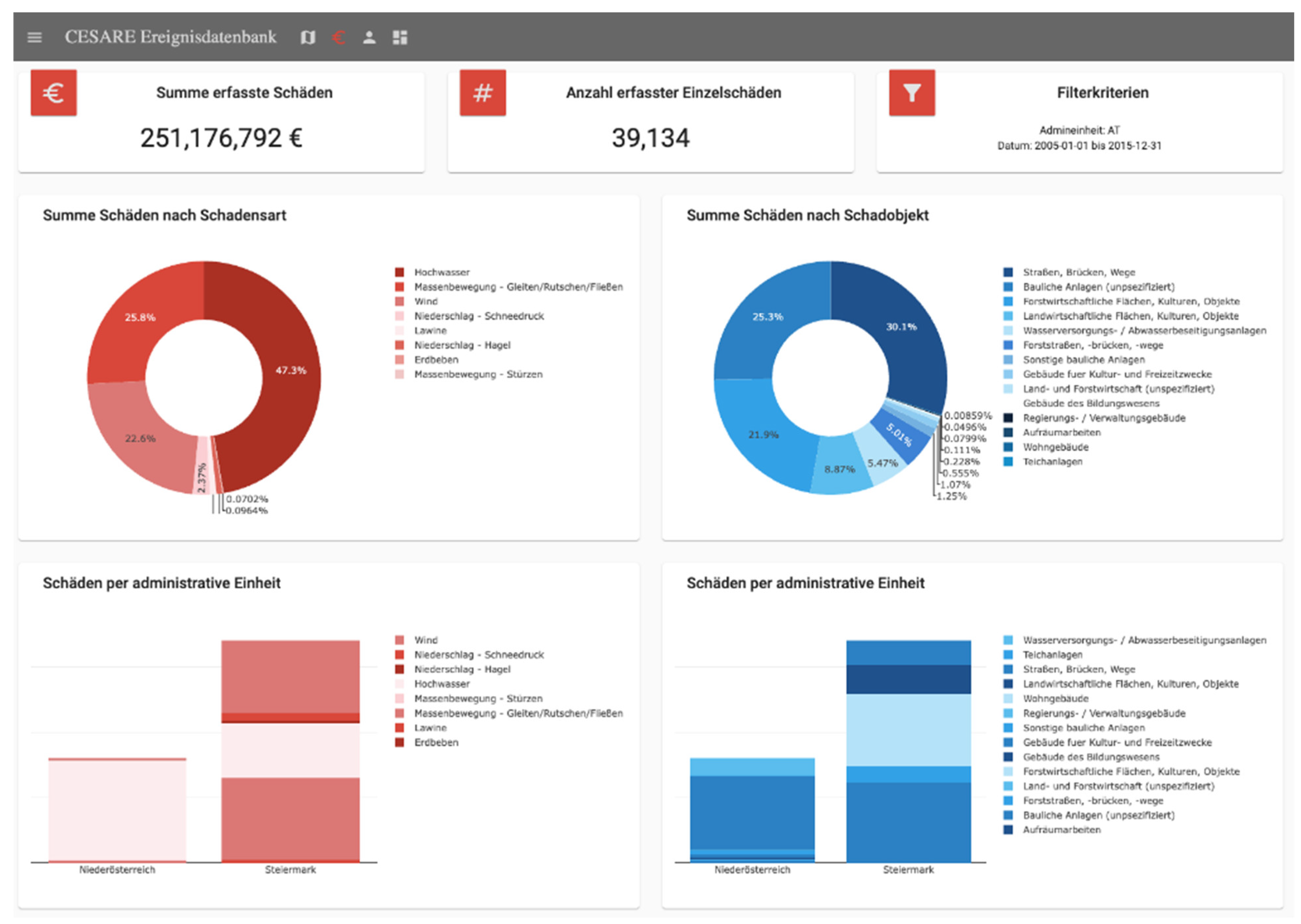
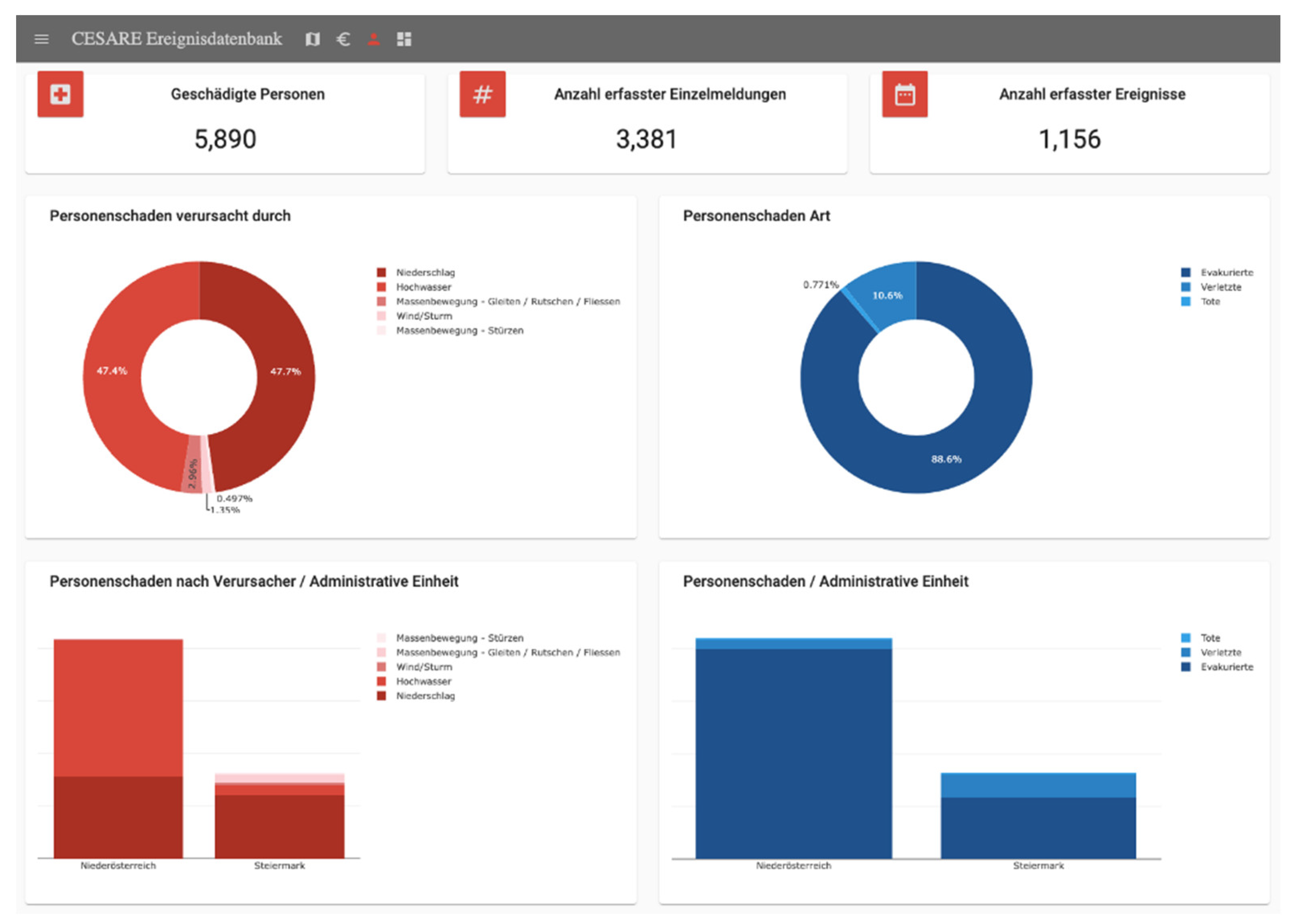
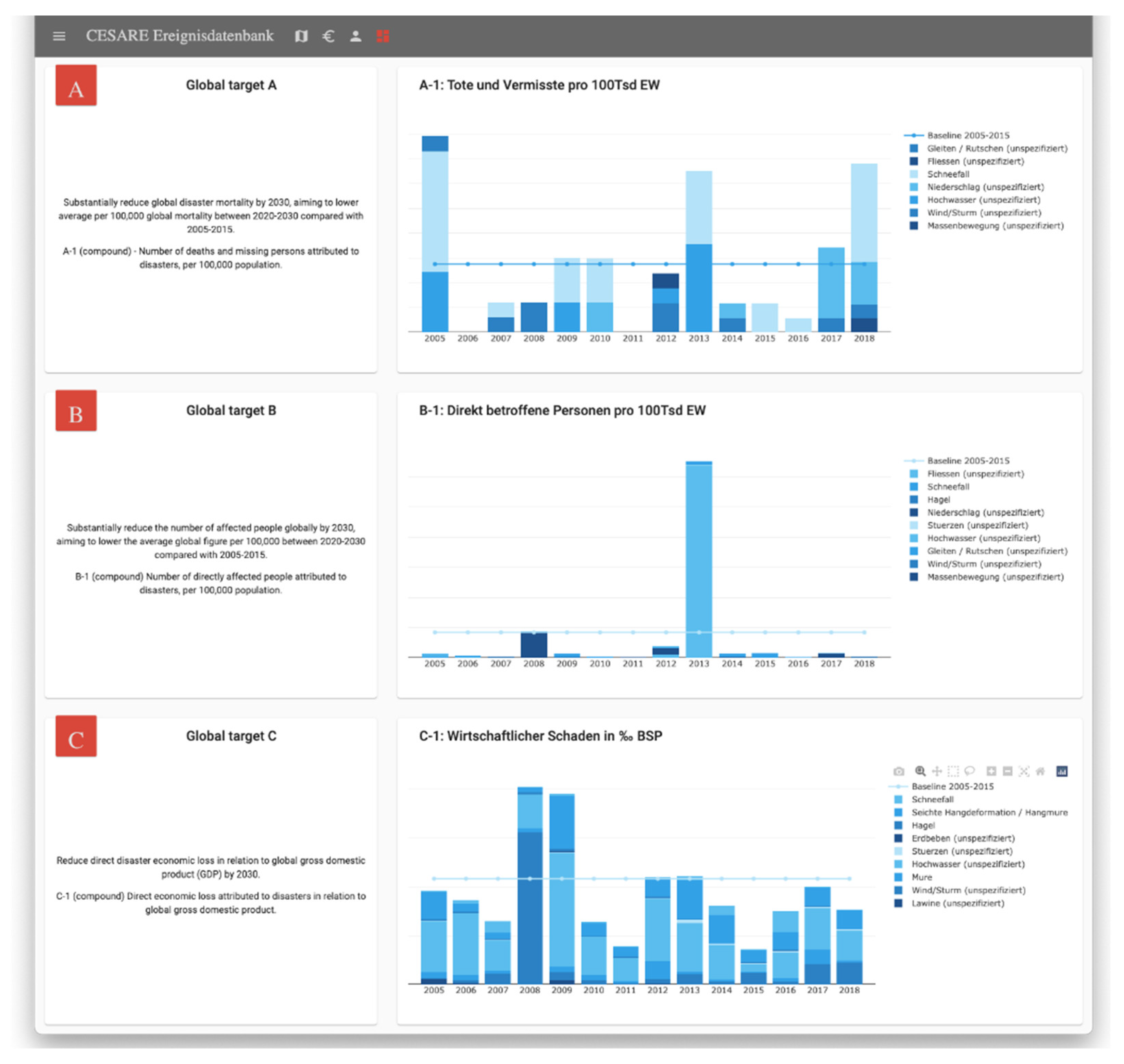
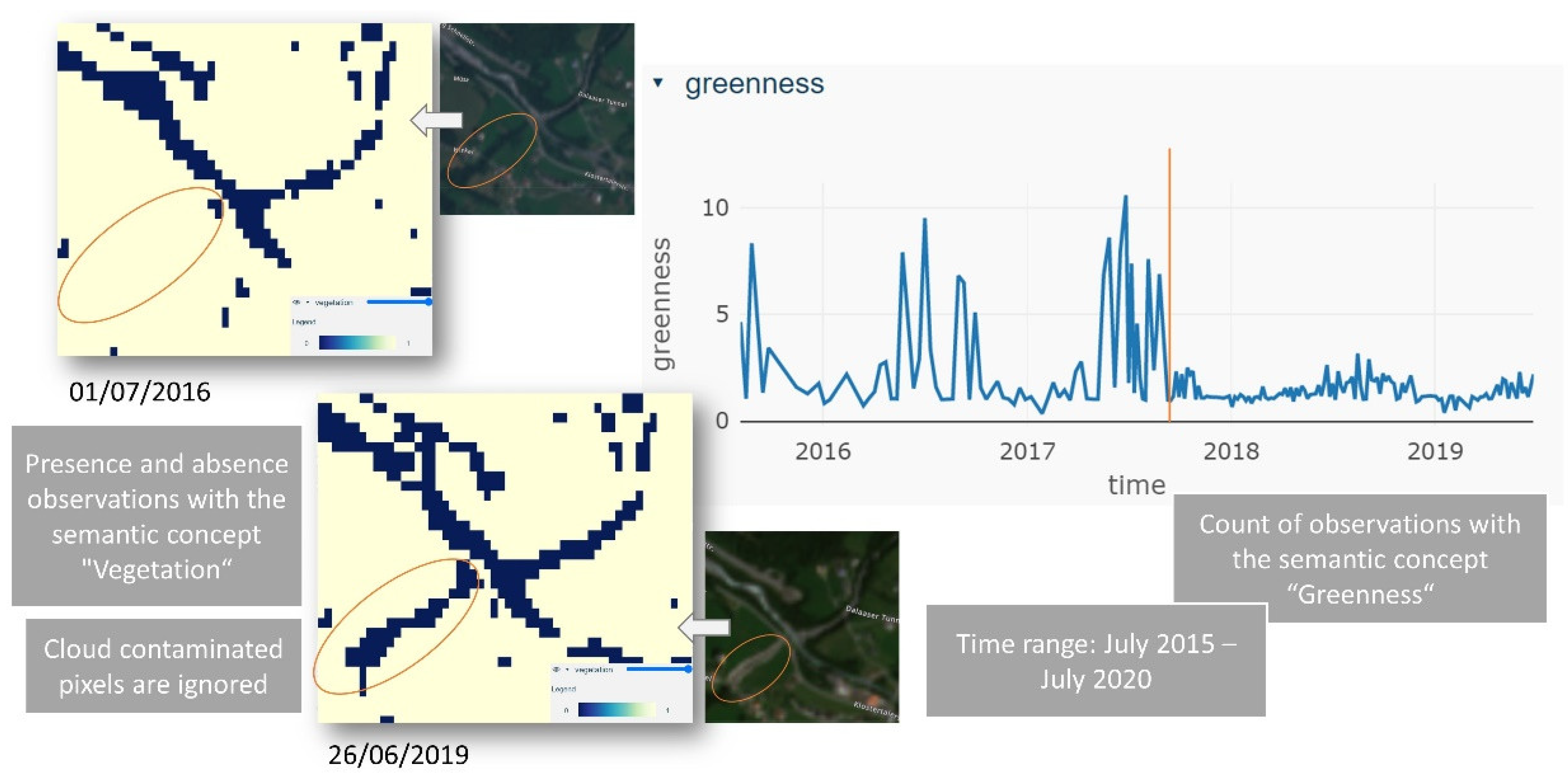

| GEORIOS | WLK | HWFDB | VIOLA | Operations Fire Brigade | Disaster Fund | |
|---|---|---|---|---|---|---|
| Short description | Documentation of events related to mass movements | Documentation of events related to torrents and avalanches | Documentation of events related to flooding | Documentation of damage-causing extreme weather events (basis: media reports) | Documentation of operations of the fire brigade in Lower Austria | Documentation of losses in public and private property eligible to compensation from the disaster fund |
| Spatial resolution | point located | point located | point or line located | polygon, state, district, municipality | usually point located | usually municipality |
| Temporal resolution | event (partly with blur) | event (partly with blur) | event (partly with blur) | event (partly with blur) | usually event | usually event (partly with blur), partly annual |
| Time coverage | since 2005 | since 2005 | since 2011/13 | since 2005 | since 2007 | since 2005/06 |
| Event documentation | yes, detailed | yes, detailed | yes, detailed | yes, detailed | no, only cause of operation | no, only cause of loss |
| Damage/loss documentation | partly, free text | yes, with differing details | yes, with differing details | yes | no | yes |
| Monetary loss | no | partly; rather rough estimates | partly; rather rough estimates | partly; rather rough estimates | no | yes |
| Relevant covered hazards * | M | F, M | F | W, F, M | W, F | W, F, M |
| Number of events or loss entries (2005–2018) | ~6400 events | ~1900 events (F, M) | ~180 events | ~1200 events | ~34,500 operations | ~103,800 loss records |
Publisher’s Note: MDPI stays neutral with regard to jurisdictional claims in published maps and institutional affiliations. |
© 2022 by the authors. Licensee MDPI, Basel, Switzerland. This article is an open access article distributed under the terms and conditions of the Creative Commons Attribution (CC BY) license (https://creativecommons.org/licenses/by/4.0/).
Share and Cite
Themessl, M.; Enigl, K.; Reisenhofer, S.; Köberl, J.; Kortschak, D.; Reichel, S.; Ostermann, M.; Kienberger, S.; Tiede, D.; Bresch, D.N.; et al. Collection, Standardization and Attribution of Robust Disaster Event Information—A Demonstrator of a National Event-Based Loss and Damage Database in Austria. Geosciences 2022, 12, 283. https://doi.org/10.3390/geosciences12080283
Themessl M, Enigl K, Reisenhofer S, Köberl J, Kortschak D, Reichel S, Ostermann M, Kienberger S, Tiede D, Bresch DN, et al. Collection, Standardization and Attribution of Robust Disaster Event Information—A Demonstrator of a National Event-Based Loss and Damage Database in Austria. Geosciences. 2022; 12(8):283. https://doi.org/10.3390/geosciences12080283
Chicago/Turabian StyleThemessl, Matthias, Katharina Enigl, Stefan Reisenhofer, Judith Köberl, Dominik Kortschak, Steffen Reichel, Marc Ostermann, Stefan Kienberger, Dirk Tiede, David N. Bresch, and et al. 2022. "Collection, Standardization and Attribution of Robust Disaster Event Information—A Demonstrator of a National Event-Based Loss and Damage Database in Austria" Geosciences 12, no. 8: 283. https://doi.org/10.3390/geosciences12080283
APA StyleThemessl, M., Enigl, K., Reisenhofer, S., Köberl, J., Kortschak, D., Reichel, S., Ostermann, M., Kienberger, S., Tiede, D., Bresch, D. N., Röösli, T., Lehner, D., Schubert, C., Pichler, A., Leitner, M., & Balas, M. (2022). Collection, Standardization and Attribution of Robust Disaster Event Information—A Demonstrator of a National Event-Based Loss and Damage Database in Austria. Geosciences, 12(8), 283. https://doi.org/10.3390/geosciences12080283







